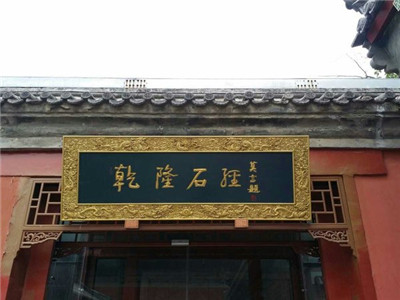After a wave of criticism online, administrators of the Confucius Temple in Beijing said they plan to replace a plaque bearing an inscription by Mo Yan, who was awarded the 2012 Nobel Prize in Literature.The wooden plaque features the characters “Qian Long Shi Jing,” or Stone Classics of Qian Long, and is the marker for an exhibition hall housing stone tablets engraved with excerpts from Confucian classics during the reign of the 18th-century emperor Qian Long. Three smaller characters indicate that the inscription is by Mr. Mo.
在网上出现一波批评声音之后,北京孔庙的管理人员表示,他们将替换由2012年诺贝尔文学奖得主莫言题写的额匾。这块木匾上的汉字为“乾隆石经”,悬挂该牌匾的大厅里保存着18世纪乾隆皇帝统治时期留下的刻有儒家经典文字的石碑。额匾落款的三个小字写着“莫言题”。

The plaque was installed in 2013, but a photograph and a scathing comment posted online this month set off a debate about the propriety of placing an inscription by a writer best known for his earthy tales of rural life in such a hallowed venue. Just as jarring to traditionalists is the fact that the characters were written left to right, instead of right to left, as is the norm in classical Chinese.
这块额匾于2013年开始悬挂,不过,本月在网上出现的一张照片和一条犀利的评论引发了争论。争议之处在于,在这样一处圣地悬挂以创作通俗农村故事出名的作家的题字是否恰当。同样令恪守传统的人士不满的是,这几个汉字是从左往右写的,而中国古代的惯常写法是从右往左。
In a comment posted on Sina Weibo on May 10, Ren Zhong, a researcher at the Confucius Institutes of Renmin University and the director of Rujia Net, a website devoted to Confucianism, wrote: “It is shocking that a plaque carved with Mo Yan’s writing has been displayed as the name plaque for the hall.” He also objected to the left-to-right order of the characters.
人民大学孔子研究院研究员任重于5月10日在新浪微博上发布了一条评论,其中写道:北京孔庙“在大厅门上悬挂莫言题写的牌匾,令人吃惊。”此外,他还谴责了这些题字从左往右的书写顺序。任重同时在儒家网担任主编,而这是一家致力于研究儒学的网站。
The comment was reposted more than 400 times and attracted coverage in the state news media. Although modern Chinese writing usually runs left to right, many Weibo users criticized that usage at the temple, one of the most important Confucian institutions in China, as a sign of disrespect.
这条帖子被转发了超过400次,官方新闻媒体也对其进行了报道。尽管当代中国书法的书写顺序通常是从左往右,但许多微博用户批评,孔庙是中国最重要的儒学机构之一,这样的写法用在那里是一种不敬。
“Wrong direction,” one commenter wrote under the name Mr. Li Eating Chestnuts With His Wife. “Are we abandoning our traditional culture now?”
“方向错了,”一名叫做“李公子携眷吃栗子”的用户写道。“是连文化传统都不要了吗?”
They also questioned whether being awarded a Nobel Prize qualified a writer to be honored in a place dedicated to ancient Chinese learning.
他们还质疑,一名作家获了诺贝尔奖,是否就有资格为专事古经研习的地方题字?
“The Nobel Prize is just a product representing Western culture,” one commenter wrote. “A Chinese who was awarded but refused the prize would be more qualified to provide the inscription.”
“诺奖可是西方文化产物,”一名用户写道。“若以后有一国人得奖而拒之,应该比莫言更有资格为匾额提字。”
In an interview, Chu Hung-lam, director of the Confucius Institute of Hong Kong, agreed that the plaque was at odds with convention. “It is kind of inappropriate for traditional buildings, although on rare occasions it does appear,” he said of the direction in which the inscription was engraved. “Traditionally, inscriptions run from right to left.”
香港孔子学院院长朱鸿林(Chu Hung-lam)在采访中表示,他也认为这块额匾不合常规。“对于传统建筑而言,这有些不协调,尽管少数情况下的确会出现,”谈到题字方向时,他说。“传统上,题字是从右向左的。”
The Beijing Municipal Administration of Cultural Heritage, which oversees the management of the temple and other cultural sites in the city, said that Mr. Mo had been invited to provide an inscription because of his literary accomplishments.
负责管理北京地区庙宇等文化古迹的北京市文物局称,之所以邀请莫言题字,是因为他取得的文学成就。
“We wanted to honor Mo Yan for his achievement as the first Chinese laureate of the Nobel Prize in Literature,” the administration’s publicity department wrote in an email late Friday. “We also wanted to emphasize the importance of promoting traditional Chinese culture in modern society.”
“这一举措,是为了表达对中国历史上第一位诺贝尔文学奖得主莫言先生的礼遇,”文物局宣传部周五晚些时候在电子邮件中称。“也藉此唤醒观众对中国文化特别是传统文化的推崇和重视,做到古为今用。”
As for the decision to reverse the traditional order of the characters, it said: “In order to show that we are keeping up with modern developments, we followed the modern writing style and carved the inscription from left to right.”
至于颠倒传统书写方向的决定,邮件说:“秉着尊重传统,与时俱进的原则,我們遵从现代书写方式,题写了该匾额。”
After considering “suggestions from Internet users” and “with the agreement of Mo Yan,” however, the temple’s administrators have decided to replace the plaque with characters in the more traditional order. They did not say when this would happen.
然而,在考虑“网民的意愿及合理性建议”和“征求莫言先生的意见”之后,孔庙的管理方决定用更符合传统顺序的题字来替换这块额匾。不过,他们并未披露将何时采取行动。













